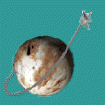
Current Issues:
SpaceViews
SpaceViews Update
Breaking News
Back Issues
Search
Subscriptions
Submissions
Forum
Space Sites of the Week
Home
Mars Pathfinder
Comet Hale-Bopp
Top Ten Stories of '96
Life on Mars?
Pathfinder's Early Science: Interesting Geology, Boring Weather
The images and other data returned by Pathfinder in the days after its successful landing provided evidence that the terrain around the landing site was quite varied and had once been subject to "catastrophic" flooding, while the atmosphere was, in the words of one scientist, "boring".
![[image of Martian rocks and soil]](../970715/images2/marssoil.jpg) Within a few days of Pathfinder's landing, images returned by the lander provided strong evidence that the site had once experienced flooding on the scale of the creation of the Mediterranean Sea.
Within a few days of Pathfinder's landing, images returned by the lander provided strong evidence that the site had once experienced flooding on the scale of the creation of the Mediterranean Sea.
Images showed large boulders, a meter or more in diameter, stacked against one another. This placement required either great luck in coincidentally placing the boulders by each other, or a flow of liquid water that carried the boulders and set them down.
Other images showed evidence of layering in nearby rocks as well as the distant pair of hills dubbed "Twin Peaks", which could have been caused by sedimentary activity. Some images showed patches of soil that appeared to be dried up puddles, while other images showed a set of wavelike ridges and gullies that could have been shaped by liquid water.
Evidence of past liquid water on Mars in important since it could show Mars was once a more hospitable place for life to develop. "The implications are enormous because liquid water is the key ingredient for life," said project scientist Matthew Golombek.
Analysis of the first rock visited by the Sojourner rover, "Barnacle Bill", showed its composition to be like andesite, a terrestrial igneous rock associated with volcanic eruptions. Barnacle Bill also showed more free quartz than expected, which can also be interpreted by a volcanic origin.
![[image of rover and Barnacle Bill]](../970715/images2/sojbill.jpg) Other rocks that will likely be visited by the rover include Yogi, the center of Sojourner's attention for the last several days, Casper, and Scooby-Doo, a "whitish" rock that is much lighter in color than other rocks in the area.
Other rocks that will likely be visited by the rover include Yogi, the center of Sojourner's attention for the last several days, Casper, and Scooby-Doo, a "whitish" rock that is much lighter in color than other rocks in the area.
Preliminary results from an experiment to test the magnetic properties of Martian dust appear to show that all Martian dust is more or less magnetic. The key mineral associated with the magnetism is maghemite, which is used in computer hard drives on Earth.
While scientists studied the surprises returned about Martian geology in the images, data from the lander's weather station showed an unchanging climate, with temperatures ranging from 10 F (-12 C) in the day to -100 F (-73 C) at night.
Data on atmospheric temperatures returned during the descent through the Martian atmosphere showed the lower atmospheric temperatures were largely unchanged from those measured by the two Viking landers 21 years ago.
However, upper atmospheric conditions, above about 60 km (37 mi.) altitude, are considerably colder now than during the Viking landings. The temperature reached a minimum of -275 F (-170 C) 80 km (50 mi.) above the surface, the coldest temperature ever recorded in the Martian atmosphere.
